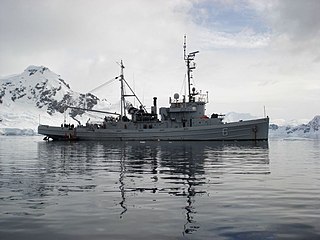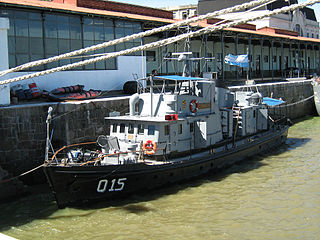
USS Cahuilla (ATF-152) was an Abnaki class fleet tug in the service of the United States Navy during World War II. In 1961 she was sold to the Argentine Navy as ARA Irigoyen (A-1) where she served until 2009 when she became a Museum ship.

HMS Caicos was a Colony-class frigate of the United Kingdom that served during World War II. She was originally ordered by the United States Navy as the Tacoma-class patrol frigate USS Hannam and was transferred to the Royal Navy prior to completion. It was named after the Caicos Islands.

ARA Puerto Deseado (Q-20) is an oceanographic survey ship in service in the Argentine Navy. She has a reinforced hull in order to operate in waters around Antarctica.

ARA Suboficial Castillo (A-6) was an Abnaki-class tug/patrol boat of the Argentine Navy. She previously served in the United States Navy as USS Takelma (ATF-113) from 1944 to 1992. The ship was acquired by Argentina in 1993 and was in service until the 2020s. In 2022, the ship was put up for sale. Suboficial Castillo was used as support ship for both the Argentine Submarine Force and during the summer campaigns in Antarctica in the Patrulla Antártica Naval Combinada with the Chilean Navy to guarantee safety to all touristic and scientific ships that are in transit within the Antarctic Peninsula.

ARA La Argentina was a steam corvette that served as a training ship with the Argentine Navy between 1884 and 1895, and in other roles until decommissioned in 1899.

ARA Azopardo is a World War II era Argentine Navy warship, originally classified as patrol boat and later as antisubmarine frigate. The vessel is named after Juan Bautista Azopardo, an Argentine naval officer that served in both the Argentine War of Independence and in the Cisplatine War. It is the third Argentine naval ship with this name.

ARA Piedra Buena is a World War II era Argentine Navy warship, originally classified as patrol boat and later as antisubmarine frigate. The vessel is named after Luis Piedrabuena, an Argentine mariner that explored and guarded Argentine sovereignty in Patagonia. It is the third Argentine naval ship with this name.

ARA Paraná was a steam and sail corvette built in United Kingdom in 1873 which served as a gunboat with the Argentine Navy between 1874 and 1899. It was decommissioned in 1900, converted to a transport and renamed Piedrabuena.

ARA Cormorán (Q-15) is a hydrographic survey boat of the Argentine Navy, built in the Río Santiago Shipyard and based in Buenos Aires. The vessel is named after the cormorant, a seabird that inhabits Argentina’s littoral, and is the fourth Argentine naval ship with this name.
ARA Petrel was a hydrographic survey boat of the Argentine Navy, built in the Cadenazzi Shipyard and based in Buenos Aires. The vessel is named after the petrel, a seabird that inhabits Argentina's littoral, and is the third Argentine naval ship with this name.
ARA Azopardo was a tugboat of the Argentine Navy, built in the Bethlehem Shipyard in 1919 and transferred to Argentina in 1922. It was based at the port of Buenos Aires and later at Puerto Belgrano, and was decommissioned in 1941. The vessel was named after the Juan Bautista Azopardo, a Maltese privateer and officer of the Argentine Navy during the Independence and Cisplatine wars, and was the second Argentine naval ship with this name.
ARA Azopardo was a steam transport of the Argentine Navy, built in the Stabilimento Tecnico Triestino and sold to Argentina in 1884. It was based, among others, in the port of Buenos Aires and later Ushuaia, and was decommissioned in 1922 after being sunk in an accident; it was refloated and sunk in 1924 as a target. The vessel was named after the Juan Bautista Azopardo, a Maltese privateer and officer of the Argentine Navy during the Independence and Cisplatine wars, and was the first Argentine naval ship with this name.

The Azopardo-class frigates were a class of two post-World War II warships, designed and built in Argentina in 1940-1959, originally as part of a class of four large minelayers. They were in service with the Argentine Navy from the mid-1950s to 1972. The class was named after Juan Bautista Azopardo, an Argentine naval officer in the Independence and Cisplatine wars.

ARA Cabo de Hornos (B-5) was a cargo ship in service with the Argentine Navy since 1979, capable of transporting bulk cargo, live cattle, and containers. She was the second ship in the Argentine Navy to bear the name of the Cape Horn (Chile) located to the south of Tierra del Fuego.

ARA Canal Beagle (B-3) is a cargo ship in service with the Argentine Navy since 1978, capable of transporting bulk cargo, live cattle, and containers. She is the second ship in the Argentine Navy to bear the name of the Beagle Channel in the south of Tierra del Fuego.

The Costa Sur-class cargo ship is a class of three cargo ships designed and built in Argentina in 1975–1979 for servicing the Patagonic coast routes; capable of transporting bulk cargo, live cattle, and containers. The ships have been in service with the Argentine Navy since 1978. The class is named after the southern coastal area of Argentina which was designed to service.
ARA Ingeniero Julio Krause (B-13) was an oil tanker ship in service with the Argentine Navy from 1993 to 2015, and with YPF from to 1981 to 1993. She was the first ship in the Argentine Navy to bear the name of Argentine engineer Julio Krause, who discovered oil in Comodoro Rivadavia in 1907.
ARA Luisito (Q-51) is a training ship of the Argentine Navy, in service since 1985 and based in Mar del Plata; where she is used to train students from Argentina’s National Fishing School. The vessel is the first Argentine naval ship with this name.












